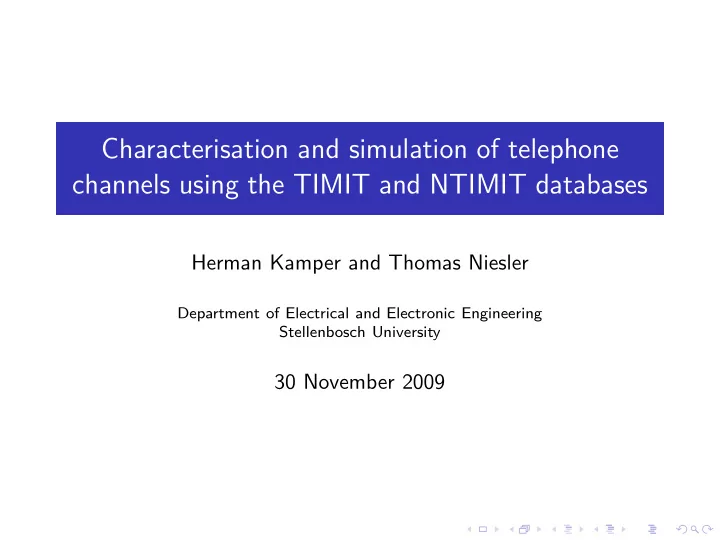

Characterisation and simulation of telephone channels using the TIMIT and NTIMIT databases Herman Kamper and Thomas Niesler Department of Electrical and Electronic Engineering Stellenbosch University 30 November 2009
Introduction ◮ Speech recognition systems are often telephone-based ◮ Requires speech recorded over a variety of telephone channels ◮ Compilation of such corpora often expensive or impractical ◮ Paper describes techniques that allow a variety of telephone channels to be simulated, given wideband recordings
Analysis of telephone channels ◮ Used the TIMIT and NTIMIT corpora ◮ Investigated channel (bandlimiting) characteristics ◮ Investigated noise which is added by telephone channel x [ n ] y [ n ] Telephone TIMIT NTIMIT channel
Model of the telephone channel w [ n ] Colouring filter v [ n ] White noise σ 2 ˆ G ( z ) w Coloured noise x [ n ] u [ n ] y [ n ] Channel Wideband Bandlimited + ˆ + output input H ( z )
Channel analysis ◮ Parametric channel modelling was evaluated (below) ◮ Spectral channel analysis techniques were also evaluated ◮ Used synthetic filters to evaluate the different techniques Telephone NTIMIT channel y [ n ] x [ n ] e [ n ] + TIMIT − y [ n ] ˆ Model ˆ H ( z )
Design of channel model ◮ Analysed the 253 NTIMIT telephone channels ◮ Used a spectral analysis technique ◮ Two possibilities for channel model: Use filter from channel library Generate random filter based on distributions 10 Average Standard deviation interval 0 −10 Amplitude (dB) −20 −30 −40 −50 −60 0 1000 2000 3000 4000 5000 6000 7000 8000 Frequency (Hz)
Noise analysis I ◮ Used 100 noise segments from arbitrary NTIMIT utterances ◮ Analysed segments to determine spectral characteristics of additive noise of the NTIMIT telephone channels ◮ Assumed noise segments to be output from LP filters ◮ Designed colouring filter based on the mean LP spectrum w [ n ] Colouring filter v [ n ] White noise Coloured σ 2 ˆ noise G ( z ) w
Noise analysis II 35 Average 30 Median 90% interval 25 20 15 Amplitude (dB) 10 5 0 −5 −10 −15 −20 0 1000 2000 3000 4000 5000 6000 7000 8000 Frequency (Hz)
Design of noise model 35 Mean LP spectrum 30 Desired amplitude response 25 20 15 Amplitude (dB) 10 5 0 −5 −10 −15 −20 0 1000 2000 3000 4000 5000 6000 7000 8000 Frequency (Hz)
Implementation in software w [ n ] Colouring filter v [ n ] White noise σ 2 ˆ G ( z ) w Coloured noise x [ n ] u [ n ] y [ n ] Channel Wideband Bandlimited + ˆ + output input H ( z )
Evaluation: Single NTIMIT channel I −20 PDS of NTIMIT speech PDS of TIMIT speech −30 −40 Power density spectrum (dB) −50 −60 −70 −80 −90 −100 0 1000 2000 3000 4000 5000 6000 7000 8000 Frequency (Hz)
Evaluation: Single NTIMIT channel II −20 PDS of NTIMIT speech PDS of y[n] with noise −30 −40 Power density spectrum (dB) −50 −60 −70 −80 −90 −100 0 1000 2000 3000 4000 5000 6000 7000 8000 Frequency (Hz)
Evaluation: Single NTIMIT channel III −20 PDS of NTIMIT speech PDS of y[n] without noise −30 −40 Power density spectrum (dB) −50 −60 −70 −80 −90 −100 −110 0 1000 2000 3000 4000 5000 6000 7000 8000 Frequency (Hz)
Evaluation: ASR systems I TIMIT BPF Software Test Test HTK HTK NTIMIT system system Accuracy Accuracy
Evaluation: ASR systems II Training set Test Set % Accuracy NTIMIT NTIMIT 40.65% TIMIT narrowband NTIMIT 32.56% Filtered TIMIT, 30 dB noise NTIMIT 36.34% Filtered TIMIT, no noise NTIMIT 32.19%
Conclusion I ◮ Accuracy obtained using the third system 10.6% lower than accuracy using the NTIMIT training set ◮ 11.6% increase in accuracy from basic bandpass approach ◮ When no noise is added, performance is not much different from the TIMIT approach
Conclusion II ◮ Leads to the conclusion that the noise model is the most important aspect of the complete model ◮ Possible reasons for this: Cepstral mean normalization Stationarity of channel models ◮ Experiments to confirm and investigate the above are the subject of ongoing work
Recommend
More recommend